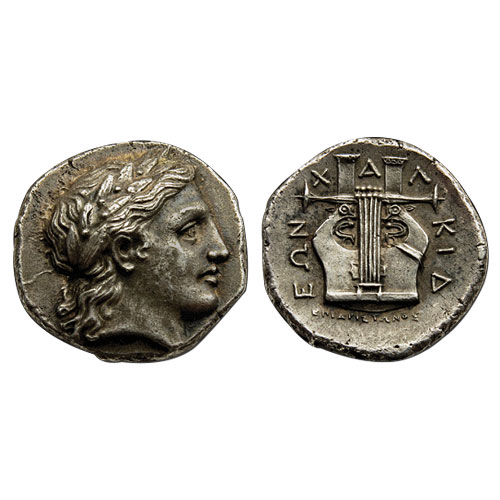Greek Coin Featuring the Earliest Known Predecessor of a Guitar
2018-02-01 Thu
Olynthus and the other free cities of the Chalcidice came together to form the Chalcadian League in 432 BCE. They stood together against the powerful Athens and Macedonian Kingdom. Athens focussed on the Peloponnesian War and never paid attention to the Chalcadian League. That’s the reason why Athens could not break this union for a long time. Olynthus was Chalcadian League’s capital on northern Ancient Greece, on the coast of Aegean Sea.The Chalcadian League became extremely powerful by the late fifth century BCE but later had to face a lot of internal conflicts. Amyntas III of Macedonia was attacked by Illyrians in 393 BCE. The territory was transferred to Olynthus for protection. However, he never got his land back from the League even after he got back his power. Amyntas III had to take help from Sparta. There was unrest within the League as well because some claimed that they were forced to be a part of the League.
This resulted in a war and Sparta gained control in 379 BCE. Even after the defeat, Chalcadian League quickly began to regain power. Philip II of Macedon destroyed Olynthus in 348 BCE and crushed the League completely. The coin shown above was minted at Olynthus during this period.
Silver coinage based on the Macedonian standard was used as legal tender within the League. Although the overall design elements remained the same, style changed over time. The obverse features Apollo and highlights the beauty of die engraving in that era. The reverse depicts a kithara. The standard lyre was commonly used as a folk instrument. The kithara was played only by skilled musicians called kitharodes and the singers of Greek epic poetry. The name “guitar” also came from the Greek kithara. The kithara symbolized wisdom and represented Apollo as well. It comprised of a box-shaped body with two parallel arms. Almost 12 strings could be attached to it. It was played like a modern-day guitar but vertically.
This coin is a part of Rene Baron Collection. The 14.40 g silver Tetradrachm was struck for the Chalcidian league between 355 and 352.
Latest News
-
Gold Pagoda of Vijaynagar Empire King Deva Raya I
2024-04-10 WedKing Deva Raya I of the Vijayanagara Empire was a patron of Kannada literature and architecture. He ...
-
Silver Denarius of Septimus Severus
2024-04-05 FriLucius Septimius Severus served as the Roman emperor from 193 to 211 AD. Severus sat on the throne o...
-
Extremely rare 'Malaharamari' type Gold Gadyana of King Guhalladeva-III Sold for INR 611000
2024-04-03 WedTribhuvanamalla, also known as Guhalladeva III, was the ruler of the Kadamba dynasty. His reign coin...
-
90 Years of RBI
2024-04-02 TueOn 1st April, PM #Modi unveiled a special commemorative coin marking 90 Years since the foundation o...
-
Silver Denarius of Julia Mamaea
2024-04-02 TueJulia Avita Mamaea, a Christian Syrian noblewoman, was the mother of Roman Emperor Alexander Severus...

